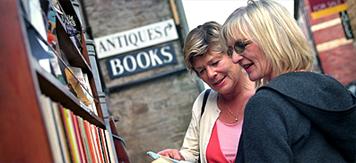


Hay Festival, Hay-On-Wye, South Wales



Ask anyone what they know about Wales and even the least informed among them is likely to say something about "that little town with all the bookstores." Indeed, with 39 bookshops in a town of only 1,300 residents, Hay-on-Wye is known worldwide as a major center of the second-hand book trade. From third printings of second-rate pulps to rare, signed first editions, Hay-on-Wye is a book lover’s paradise.
And once a year it seems like every book lover in the world shows up. Started in 1988 by a few locals, the Hay Festival is now attended by upwards of 80,000 fans of culture and literature over 10 days in the late spring - the start of "festival season" in Wales. This year the festival takes place from May 26th to June 4th.
If you're thinking of attending, it's not too soon to start making plans. This year the festival will feature, among many others, poet Seamus Heaney, author Margaret Atwood, Nobel Peace Prize recipient Shirin Ebadi, sculptor and installation artist Antony Gormley and travel/cookbook author/restauranteur/raconteur Keith Floyd. Don't worry about bringing the kids too. With the young-peoples "Hay Fever" program this is definitely an "all-ages" event.
With all that activity you might be tempted to think that the Wye Valley is all about Hay-on-Wye, but there's so much more to see and do. In 1971 the Wye Valley was designated as an official Area of Outstanding National Beauty (AONB). Not only is this an acknowledgment of its exceptional visual beauty, it's also recognition of its exceptional conservation of the natural and historical landscape - and ensures its ongoing preservation. As it turns out, people have known about the beauty of this area for just a little longer than the last 30 years. Foreign "tourists" have sought out the natural beauty of the Wye Valley since the 18th century, but this is no mere picture-book landscape.
Located in the "marches," the borderlands between Wales and England, the Wye Valley has always been of importance in the political and military history of the region. The 11th century Norman castle at Chepstow, still standing today, endures, in part, because it was one of the first in Britain to be built of stone; a sign of its strategic importance. The natural richness and resources of the valley also supported thriving industrial activity, just as the Wye River, for which the valley is named, provided a major transportation system for the iron and brass that was manufactured there. In fact the first brass foundry in Britain was located in the valley at Tintern in the 1500's.
Today Tintern is far better known for the ruins of Tintern Abbey, one of the finest examples of a Cistercian Abbey still standing. Founded in 1131, it began to fall into disrepair and decay in the 1500's as King Henry VIII appropriated much of the wealth of the religious orders. Yet today, with its chapel floors carpeted in grass and its roofs open to the heavens, it stands in testament to the spirit and skill of those who built it nearly nine centuries ago.
Easily reached within an hour from the capital city of Cardiff, the 136 mile long valley is dotted with vibrant market towns and villages, medieval castles, Roman ruins, and also some of the best golfing in Britain with nearby courses such as St. Pierre, the Rolls of Monmouth and the Celtic Manor. A visit to the Wye Valley can be a day trip, a stopover en route to the Brecon Beacons and Black Mountains that border it to the north, or an entire vacation of culture, adventure or simply stunning natural beauty.
© Copyright 2005, 2006. All Rights Reserved.
